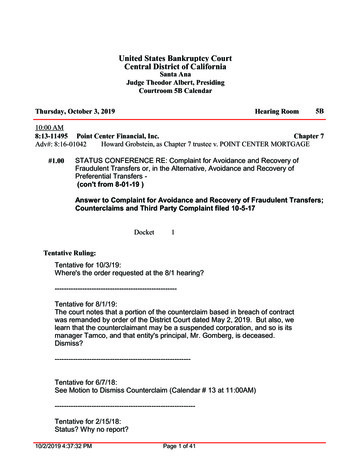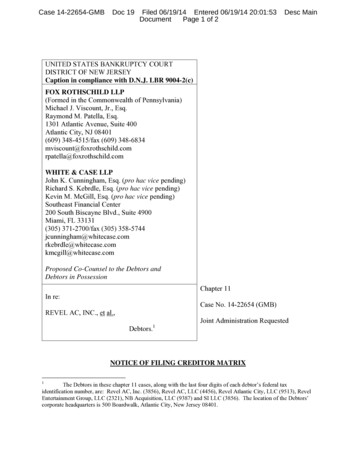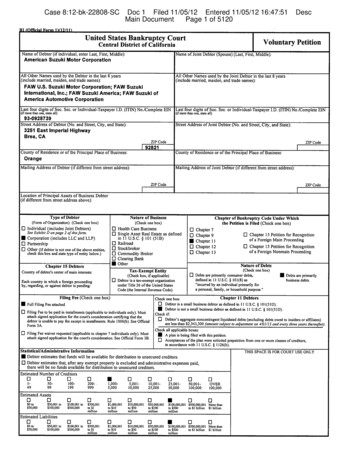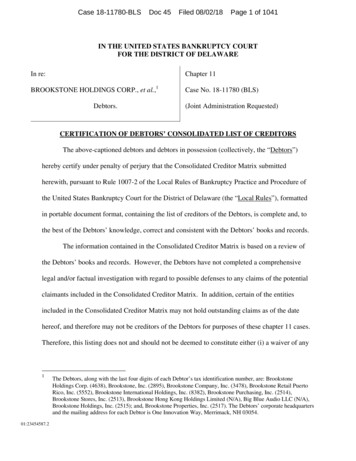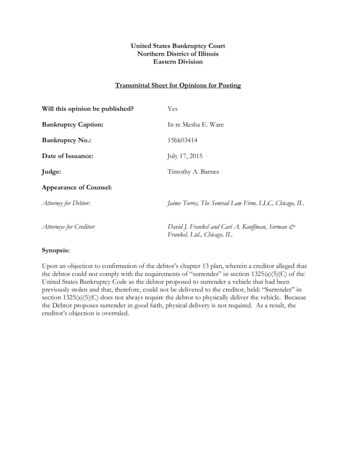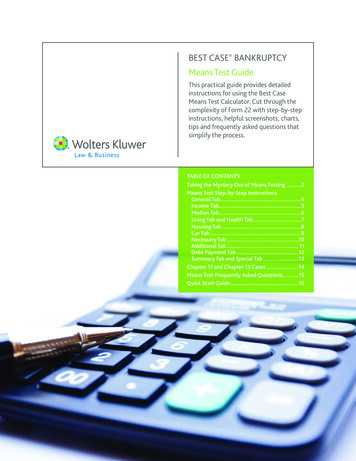
Transcription
heslaw v.2007/06/20 Prn:3/09/2007; 15:25aid: 2014 pii: S1574-0730(07)02014-2 docsubty: REV1F:heslaw2014.tex; VTEX/VJ p. 11Chapter 14232BANKRUPTCY LAW345645MICHELLE J. WHITE*6Department of Economics, University of California, San Diego7878Contents910111291. IntroductionPart A: Corporate bankruptcy2. Legal background—corporate bankruptcy law132.1. Chapter 7 liquidation142.2. Chapter 11 reorganization152.3. Non-bankruptcy workouts16173. Research on corporate bankruptcy—theory3.1. Effects of priority rules on the bankruptcy decision, managerial effort, and the choice be-18tween safe versus risky investments193.1.1. Models with complete information203.1.2. Models with asymmetric or incomplete information213.2. Proposed reforms of Chapter 11—auctions, options, and bankruptcy by contract223.2.1. Auctions233.2.2. Options243.2.3. Contracting about bankruptcy253.2.4. Contracts as substitutes for bankruptcy264. Research on corporate bankruptcy—empirical work274.1. Bankruptcy costs284.2. Deviations from the absolute priority rule29301016101910191019102110231024Part B: Personal bankruptcy5. Legal background—personal bankruptcy law315.1. Creditors’ legal remedies outside of bankruptcy325.2. Chapter 7 “liquidation”335.3. Chapter 13 “adjustment of debts of consumers with regular 2232425262728293031323334353536* Professor of Economics, University of California, San Diego, and Research Associate, NBER. I am very3637grateful to Lucian Bebchuk for comments and to the National Science Foundation for research support undergrant number 0212444. Portions of this chapter were presented at Harvard Law School, University of SouthernCalifornia Law Center, and the 2005 ALEA Conference in New York and I benefited from comments byparticipants at these talks.37Handbook of Law and Economics, Volume 2Edited by A. Mitchell Polinsky and Steven Shavell 2007 Elsevier B.V. All rights reservedDOI: 243
heslaw v.2007/06/20 Prn:3/09/2007; 15:25aid: 2014 pii: S1574-0730(07)02014-2 docsubty: REVF:heslaw2014.tex; VTEX/VJ p. 21014123M.J. White5.4. The new bankruptcy law6. Trends in personal bankruptcy filings7. Research on personal bankruptcy—theory47.1. Optimal personal bankruptcy policy—consumption insurance and work effort57.2. Additional theoretical issues7.2.1. Default versus bankruptcy7.2.2. Waiving the right to file for personal bankruptcy7.2.3. The option value of bankruptcy7.2.4. Bankruptcy and incentives for strategic behavior67891011121314151617181920212223247.2.5. Bankruptcy and the social safety net8. Research on personal and small business bankruptcy—empirical work8.1.8.2.8.3.8.4.Political economy of bankruptcyStudies of the bankruptcy filing decision using aggregate dataStudies of the bankruptcy filing decision using household-level dataEmpirical research on work effort and the “fresh start”8.5. Bankruptcy and the decision to become an entrepreneur8.6. Bankruptcy and credit markets8.6.1. General credit8.6.2. Secured versus unsecured credit8.6.3. Small business credit8.7. Macroeconomic effects of bankruptcy8.7.1. Bankruptcy and consumption insurance8.7.2. Bankruptcy and portfolio ankruptcy is the legal process whereby financially distressed firms, individuals, andoccasionally governments resolve their debts. The bankruptcy process for firms playsa central role in economics, because competition drives inefficient firms out of business, thereby raising the average efficiency level of those remaining. The main economic function of corporate bankruptcy is to reduce the cost of default by having agovernment-sponsored procedure that resolves all debts simultaneously. The main economic function of personal bankruptcy is to provide partial consumption insurance toindividual debtors and therefore reduce the social cost of debt. This chapter surveystheoretical and empirical research on both types of 343
heslaw v.2007/06/20 Prn:3/09/2007; 15:25aid: 2014 pii: S1574-0730(07)02014-2 docsubty: REVCh. 14:1F:heslaw2014.tex; VTEX/VJ p. 3Bankruptcy LawKeywords2345612Corporate bankruptcy, personal bankruptcy, small business, financial distress,reorganization, liquidation, absolute priority rule (or APR), limited liability,cramdown, prepack (or prepackaged bankruptcy), human capital, Chapter 11,Chapter 7, Chapter 13, option78101534567JEL classification: K2, G3, G33, 333434353536363737383839394040414142424343
heslaw v.2007/06/20 Prn:3/09/2007; 15:25aid: 2014 pii: S1574-0730(07)02014-2 docsubty: REV10161F:heslaw2014.tex; VTEX/VJ p. 4M.J. White1. 2526272829303132333435363738394041424312Bankruptcy is the legal process by which financially distressed firms, individuals, andoccasionally governments resolve their debts. The bankruptcy process for firms plays acentral role in economics, because competition drives the most inefficient firms out ofbusiness, thereby raising the average efficiency level of those remaining. Consumersbenefit because the remaining firms produce goods and services at lower costs andsell them at lower prices. The legal mechanism through which most financially distressed firms resolve their debts and exit the market is bankruptcy. Bankruptcy is alsothe process by which individuals and married couples in financial distress resolve theirdebts, although financially distressed individuals—unlike firms—do not shut down orexit. Governments sometimes also use bankruptcy to resolve their debts. Like individuals but unlike firms in financial distress, they do not shut down.This chapter discusses the economics of bankruptcy law. Since the literatures on corporate and personal bankruptcy have developed in isolation of each other, a goal of thischapter is to draw out parallels between them. It is useful to start by defining terms.Corporate bankruptcy refers to the bankruptcy of large- and medium-sized businesses,which for convenience I assume to be organized as corporations. Personal bankruptcyrefers to the bankruptcies of individual households and small businesses. Small businessbankruptcy is treated as part of personal bankruptcy, since small businesses are ownedby individuals or partners who are legally responsible for their businesses’ debts. Whentheir businesses fail, owners often file for bankruptcy so that their businesses’ debts willbe discharged. Even when small businesses are incorporated, owners often guaranteethe debts of their businesses, so that personal bankruptcy law applies at least in part.Regardless of whether the debtor is a business or an individual, bankruptcy law provides a collective framework for simultaneously resolving all debts when debtors’ assetsare less than their liabilities. This includes both rules for determining how much of thedebtor’s assets must be used to repay debt and rules for determining how those assetsare divided among creditors. Thus bankruptcy is concerned with both the size of thepie—the total amount paid to creditors—and how the pie is divided.For corporations in financial distress, both the size of the pie and its division dependon whether the corporation liquidates versus reorganizes in bankruptcy and corporatebankruptcy law includes rules for deciding whether reorganization or liquidation willoccur. When corporations liquidate, the size of the pie is all of the firm’s assets. The sizeof the pie reflects the doctrine of limited liability, which exempts corporate shareholders from liability for the corporation’s debts beyond loss of their shares. The proceedsof liquidating the corporation’s assets are used to repay creditors. The division of thepie follows the absolute priority rule (APR), which carries into bankruptcy the nonbankruptcy rule that all creditors must be paid in full before equityholders receiveanything. The APR also determines the division of the pie among creditors and requiresthat higher-priority creditors be repaid in full before lower-ranking creditors receiveanything. Thus under the APR, each class of creditors either receives full payment 031323334353637383940414243
heslaw v.2007/06/20 Prn:3/09/2007; 15:25aid: 2014 pii: S1574-0730(07)02014-2 docsubty: REVCh. 293031323334353637Bankruptcy LawF:heslaw2014.tex; VTEX/VJ p. 51017its claims or nothing at all (except that the lowest-ranking class of creditors to be repaidreceives partial payment).When corporations reorganize rather than liquidate in bankruptcy, the reorganizedcorporation retains most or all of its assets and continues to operate. The funds to repaycreditors then come from the reorganized firm’s future earnings rather than from saleof its assets. The rules for dividing the pie in reorganization also differ from those inliquidation. Instead of dividing the assets so that creditors receive either full paymentor nothing, most creditors receive partial payment and pre-bankruptcy equityholdersreceive some of the reorganized firm’s new shares. Bankruptcy law again provides aprocedure for determining both the size and division of the pie, but the procedure involves a negotiation process rather than a formula.For individuals in financial distress, bankruptcy also provides a framework for resolving all of the individual’s debts. Again the procedure includes both rules for determininghow much of the consumer’s assets must be used to repay debt (the size of the pie) andrules for dividing the assets among creditors (the division of the pie). In determiningthe size of the pie, personal bankruptcy law plays a role analogous to that of limitedliability for corporate shareholders, since it determines how much of their assets individual debtors must use to repay their debts. Unlike corporations, individual debtorsin bankruptcy are not required to use all of their assets to repay their debts. Instead,personal bankruptcy specifies exemption levels, which are maximum amounts of bothfinancial wealth and post-bankruptcy earnings that bankrupt individuals are allowed tokeep. Amounts in excess of the exemption levels must be used to repay debt. To dividethe pie, personal bankruptcy specifies a division rule. As in corporate bankruptcy, thedivision rule may either be the APR or a rule under which all creditors receive partialpayment.An important difference between personal and corporate bankruptcy procedures isthat true liquidation never occurs in personal bankruptcy (even though the Chapter 7personal bankruptcy procedure in the U.S. is called liquidation). Debtors’ wealth consists of two components: financial wealth (including home equity) and human capital.The only way to liquidate the human capital portion of individual debtors’ wealth wouldbe to sell debtors into slavery—as the Romans did. Since slavery is no longer used as apenalty for bankruptcy, all personal bankruptcy procedures are forms of reorganizationin which individual debtors keep their human capital and the right to use it (or not useit) after bankruptcy.1The economic objectives are similar in corporate and personal bankruptcy. One objective of bankruptcy is to repay creditors enough that credit remains available onreasonable terms. Reduced access to credit makes debtors worse off because 222324252627282930313233343536373839401391 Both Britain and the U.S. used debtors’ prison as a punishment for bankruptcy during the nineteenthcentury and, in earlier periods, Britain occasionally used the death penalty against debtors who defraudedtheir creditors. While prison and the death penalty waste debtors’ human capital, they presumably causedebtors to use their financial assets to repay debt even though the assets could otherwise be hidden fromcreditors. See Baird (1987).40414243
heslaw v.2007/06/20 Prn:3/09/2007; 15:25aid: 2014 pii: S1574-0730(07)02014-2 docsubty: 272829F:heslaw2014.tex; VTEX/VJ p. 6M.J. Whiteneed to borrow in order to start up and grow and individuals benefit from borrowing tosmooth consumption. On the other hand, repaying more to creditors harms debtors bymaking it more difficult for financially distressed firms to survive and more onerous forfinancially distressed individuals to work. Both the optimal size and division of the piein bankruptcy are affected by this tradeoff. Another way of expressing the same objective is to give both corporate and personal debtors an incentive to invest and consumeefficiently before and after they become financial distressed. A second objective of bothtypes of bankruptcy is to prevent creditors from harming debtors by racing to be firstto collect. This is because aggressive collection efforts by creditors may force debtorfirms to shut down even though the best use of their assets is to continue operating andmay cause individual debtors to lose their jobs (if creditors repossess debtors’ cars orgarnish debtors’ wages). Finally, personal bankruptcy law has an additional objectivethat has no counterpart in corporate bankruptcy—to provide individual debtors withpartial consumption insurance by discharging debt when repayment would cause a substantial reduction in debtors’ consumption levels. This is because if consumption fallssubstantially, long-term harm may occur, including debtors’ children leaving school prematurely in order to work or debtors’ medical conditions going untreated and becomingdisabilities.2In 1984, there were approximately 62,000 business bankruptcy filings and 286,000filings by individuals
Chapter 14 BANKRUPTCY LAW MICHELLE J. WHITE* Department of Economics, University of California, San Diego Contents 1. Introduction 1016 Part A: Corporate bankruptcy 1019 2. Legal background—corporate bankruptcy law 1019 2.1. Chapter 7 liquidation 1019 2.2. Chapter 11 reorganization 1021 2.3. Non-bankruptcy workouts 1023 3. Research on corporate bankruptcy—theory





